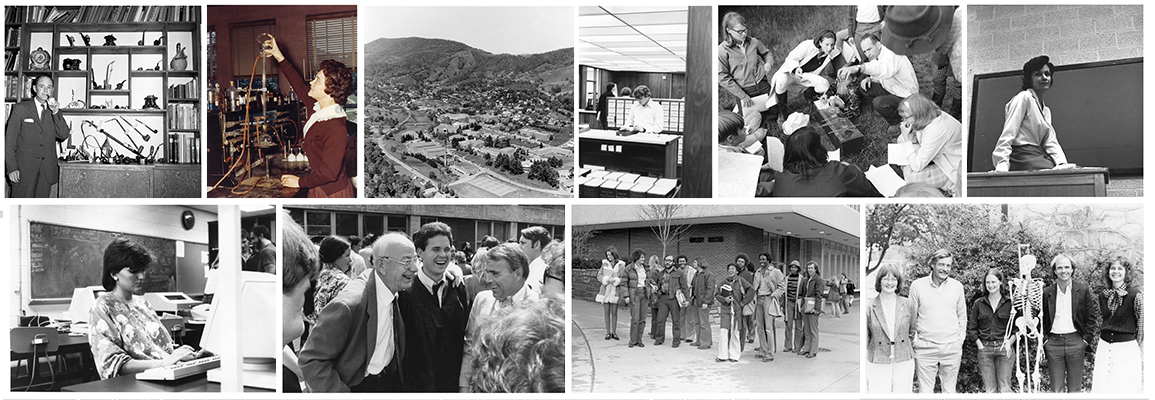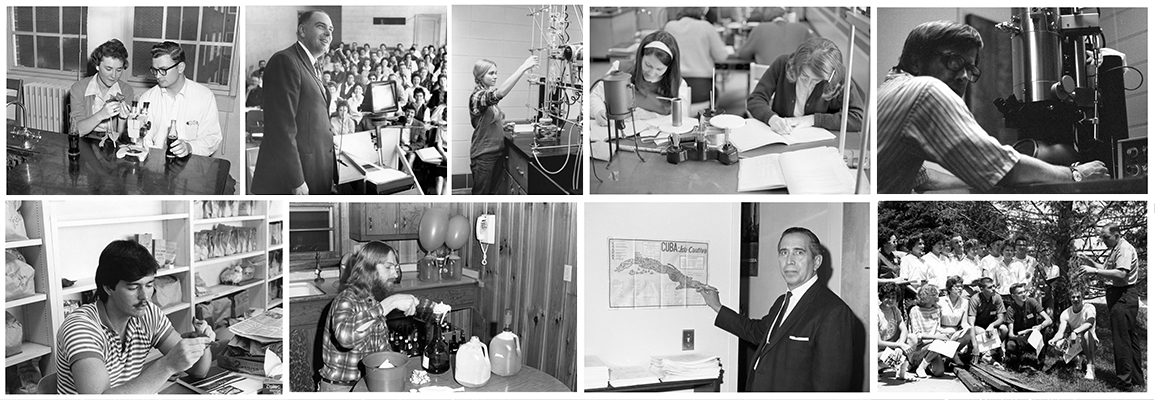
Historical Timeline of the College
1899
Watauga Academy founded “to prepare quality teachers to teach you in the “lost provinces” of Western North Carolina.”
1900
Enrollment reaches 150 with 4 students enrolled in high school.
1903
Watauga Academy becomes Appalachian Training School (ATS).
1909
Four literary societies are founded for male and female students. Male students had the Watauga and the Appalachian Societies, which met in recitation rooms weekly, and women had the Euterpean and Calliopean, which met in Lovill Home. These were the first social organizations on campus.
1910
Chapell Wilson begins teaching history and government at ATS until 1932.
1911
Science Hall, the first specialized academic campus building is completed; later destroyed by a fire in 1946.
James M. Downum joins Appalachian faculty as professor of Latin.
1920s
Art classes, glee club, literary societies, student publications and team sports flourished for women and men. The academic program targeted teacher preparation in the form of theory and supervised practical application of methods. As the curriculum expanded, the administration added subject majors in the liberal arts to supplement these education courses.
1921
Chapell Wilson supervises teacher training and begins teaching psychology.
A. J. Greene joins faculty as an assistant in Latin and English.
James D. Rankin joins faculty as professor of English.
1929
The school became a four-year, degree-granting institution named Appalachian State Teachers' College. Over 1,300 students were enrolled in the Bachelor of Science degree programs for primary grades education, physical education, math, english, science and history.
1933
The Social Science Department is established (faculty includes 1 Ph.D.; 3 M.A.s; 1 B.A.). Dr. D.J. Whitener serves as chair until 1956.
English and History majors are offered.
1934
French major is offered.
1940
Smith-Wright Hall is completed, still home to psychology and sociology classes today.
1950
The Fine Arts Building, later called I.G. Greer Hall is completed. I.G. Greer Hall is home to the Dean's office and the Department of Philosophy and Religion today.
1952
F. Ray Derrick joins as the head of the Department of Biology and served until 1973.
1954
Beta Psi Chapter of the National Honorary Biological Society, Beta Beta Beta, is established. Science Club and Beta Beta Beta embark on a program to identify and label all trees on campus.
1957
A change in N.C. Legislation recognized the teaching of liberal arts at Appalachian Teacher College as part of a statewide expansion of higher education.
1958
The first language lab is opened in the Department of Foreign Languages. It provided mainly Spanish language materials.
1960s
Student enrollment for the entire University soared to above 2,400 in 1958, only to double with baby boomers to over 5,000 by 1968; accordingly, the full-time faculty for the entire University grew to more than 300.
1960
A new electronic language lab is added for the Department of Foreign Languages in November. It officially opens in 1961 and offers Spanish and French materials.
1963
Rankin Science Building is completed. Today this building has been expanded and is home to the departments of Geological and Environmental Sciences, Geography and Planning, and Biology.
1964
In October and November, Rankin Science Hall holds evening open houses on Tuesday and Friday nights to allow students, faculty and staff use of the observatory to view stars, visible planets and the moon.
1965
The Department of Social Studies separates into the Departments of History, Political Science, Geography and Geology, and Sociology.
1967
Appalachian State Teachers College (ASTC) designated a “regional university” and name changed to Appalachian State University.
Pre-professional programs are offered in the General College, offering interdisciplinary programs for pre-law, pre-medical, pre-dental and pre-engineering degrees.
1968
Four new colleges at the University are established: General College, the College of Arts and Sciences, the College of Fine and Applied Arts and the College of Education.
Dr. William Strickland becomes the first Dean of the College of Arts and Sciences.
William Roland Neely becomes the first African-American student to graduate from Appalachian State with a B.A. in Psychology.
1969
Sanford Hall is completed and is still home to the department of English today.
Caroline Anderson becomes the first African-American full-time faculty member in the Department of Mathematical Sciences.
1969-1970
The College of Arts and Sciences has 13 departments with majors in Anthropology Biology, Chemistry, English, Foreign Languages, Geography and Geology, History, Mathematics, Philosophy and Religion, Physics, Political Science, Psychology, and Sociology.
1971
Dr. Herbert W. Wey presided over the induction of Appalachian State University into the greater University of North Carolina System.
Appalachian offers specialist degrees in biology, educational leadership, higher education and elementary education.
1972
Watauga College is founded and includes 100 freshmen, 20 sophomores, juniors and seniors (both men and women).
The first "Women in History" course is offered.
1975
Walker Hall is completed, home to the Department of Mathematical Sciences today.
Ecology is approved as a major in Community and Regional Planning in the Department of Geography.
1976
Appalachian State’s Women’s Studies Program is founded.
A B.S. degree in Mathematical Science with a Computer Science option is offered.
1979
The Center for Appalachian Studies and an M.A. in Appalachian Studies is established.
Late 1970s
The Department of International Studies is established (office created early 1970s).
1980
The Dark Sky Observatory is completed.
1984
Dr. James W. Byrd (Physics), Dean
1988
The Computer Science Program is accredited by the Computing Science Accreditation Board.
1991
Donald Sink (Chemistry), Dean
1998
Dr. Faye Sawyer, Interim Dean
1999
Dr. Linda Bennett, Dean
2003
Dr. Stan Aschleman, Interim Dean
2003
The old 1963 Rankin Science Building is demolished and Rankin Science North addition is completed.
2004
Dr. Neil Lineback, Interim Dean
2005
Dr. Robert Lyman, Dean
2008
Dr. Anthony G. Calamai (Physics and Astronomy), Dean
2016
The College of Arts and Sciences houses 16 departments, 2 programs, 2 centers, and Watauga Residential College
2017
Dr. Neva J. Specht (History), Dean
Today there are over 5,850 students and 451 full-time faculty in the College of Arts and Sciences alone.
2018
The College of Arts and Sciences celebrates 50 years! Read more about celebrating 50 years at Appalachian State University at Appalachian Today.
2020
The College hosts its inaugural Mountain Studies Lecture Series virtually due to COVID-19 in partnership with National Geographic.
2021
Dr. Michael Madritch (Biology), Interim Dean
2024
Dr. Michael Madritch (Biology), Dean
Additional Historical Resources
